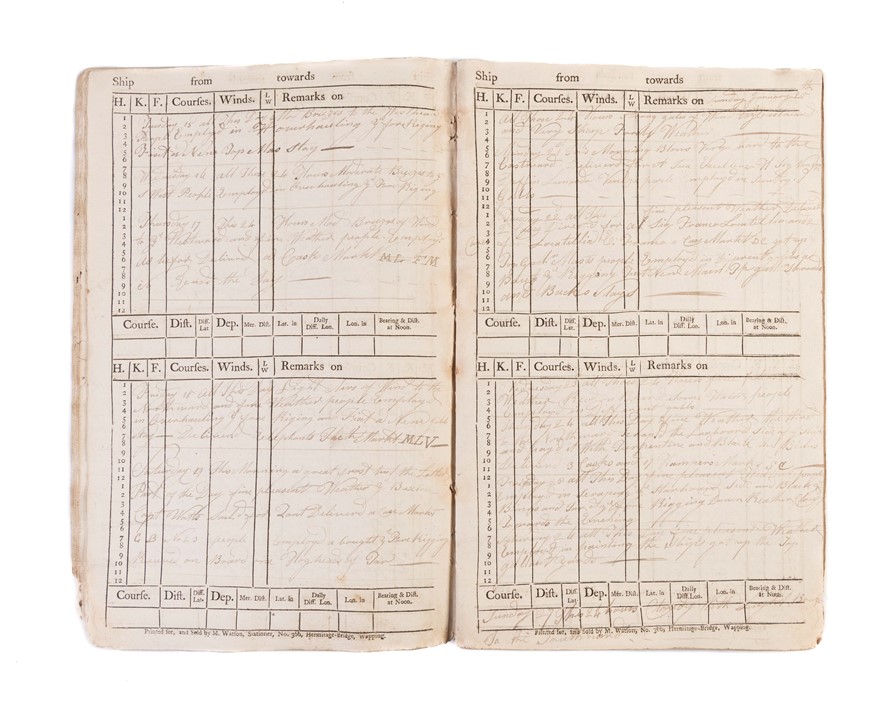Eighteenth-century printed ship's log completed in manuscript with an account of a voyage to Venice.
SHIP'S LOG ([c.1787])
£600.00
Please contact us in advance if you would like to view this book at our Curzon Street shop.
A VOYAGE FROM FALMOUTH TO VENICE, HAMBURG AND ZANTE
Folio [320 x 210 mm]. 42ff. Printed tabulated log book with entries for two days per page. Manuscript entries in ink to the first 33 leaves with additional notes in the bottom margins of odd pages, and notes of the ships name, provenance and sailing direction in the top margin. Manuscript inked entries lightly faded, occasional small ink blots and stains. Stitched as issued (wear on inner edge of first and final folios especially, with some wear on bottom edges and lower fore-corners throughout; tear to lower fore-corners of ff.31-33; slight discolouration on inner edges throughout).
London: printed and sold by M. Watson, No. 366, Hermitage-Bridge, Wapping,
Manuscript log book kept on board the merchant ship 'Alert': sailing from Falmouth towards Venice, and then on to Zante and Hamburg, 1787-88.
The Alert set sail on 28 November, 1787 and travelled around the coasts of France, Spain and Portugal, sighting Cape St Vincent on Dec. 8, sailing through the strait of Gibraltar, past Cape Degatt (Cabo De Gata, Spain) on Dec. 21; around the heel of Italy and up its west coast, sighting the church steeple of Rovigno, in Istria (Rovinj, Croatia) on Dec. 29; taking on a pilot and supplies and arriving at Venice, mooring at Malamocco on Dec. 31, 'and so ends the year.'
Alert was docked at Malamocco until March 9, 1788, trading in goods, predominantly food but also other items, including 'Elephants Teeth' (Jan. 18). From there it sailed to the island of Zante, off the Greek coast, arriving there on March 23 and travelling on to Hamborough (Hamburg), on Apr. 4, catching a porpoise (Apr. 6) en route; continuing via Malta (sighted Apr. 13); Gibraltar (Apr. 28); Cape St Vincent (May 1); Scilly Isles (May 13); Beachy Head (May 20); Fruburgh (Freiburg, May 26); and arriving in Hamburg on 28 May, 1788.
While the Alert was under sail, entries describe weather conditions at sea, but also feature occasional meetings with other ships ('hoist'd our colours to a Frenchman', Dec. 1; 'three large ships in sight, and a brig', Apr. 17, 1788; 'spoke a Dutchman from Smyrna', Apr. 20, 1788), and the taking on of additional crew and supplies at port. While docked in the Venice lagoon and at Zante and Hamburg, the nature of accounts shifts to describe other activities undertaken by the crew and the journal's owner, Morgan Rayne, including 'knoting rope yarn', 'cleaning the ship', 'delivering hogsheads of fish', mending the sails and so on. The journal contains some account of the quantities of goods 'discharged and delivered', and the merchant's marks on the containers being unloaded.
The journal ends on 7 June, 1788, while the 'Alert' was still docked at Hamburg; the final 19 pages are blank, although newspaper accounts of shipping news in subsequent years do indicate that the 'Alert' continued to trade on this route certainly into the later eighteenth century. It was a dangerous time for merchant ships in foreign waters, particularly in the Mediterranean and along the route taken by this vessel; French privateers captured British merchant ships (and vice versa) and disrupted established trade routes with increasing frequency, as Franco-British hostility heightened prior to the outbreak of the Napoleonic War.
Little is known of the log book's owner. Handwritten notes at the bottom of odd pages read 'Morgan Rayne His Journal Book' and 'Morgan Rayne Norton'.
The journal itself was purchased pre-printed from Michael Watson, a stationer, printer and bookseller based in Wapping, London. He traded from the address printed on this journal, 366 Hermitage Bridge, until the end of the eighteenth century; by 1804 the premises had moved to 340 Wapping Street, from where his son continued the trade until his death in 1851. While they sold an array of popular literature, trade cards in the British Museum's Banks collection indicate that the Watsons specialised in 'books and charts for exportation', 'stationery for exportation', 'sea charts...for all parts of the world', and 'periodicals and other publications', including accounts of voyages (Botany Bay, 1788; A Voyage to the Pacific Ocean, 1793), maritime fiction (The Guinea Outfit; or, the Sailor's Farewell, a Comedy, 1800) and songs (Songs &c. in the Deserter of Naples, 1788). This emphasis on portable stationery, charts and publications on sea-faring is particularly fitting for a stationer based in an area of London that, due to its proximity to the river, was well known for its maritime trades and industries. Replacing hand-drawn logbooks, pre-printed logs of this sort were sold in port towns and widely used in shipping by this time; they became standard issue for the Royal Navy after 1799.
.
Stock Code: 222590







